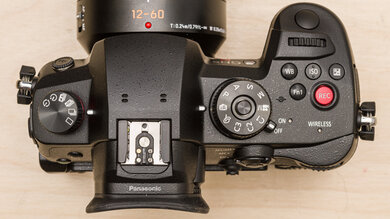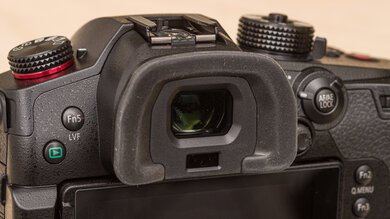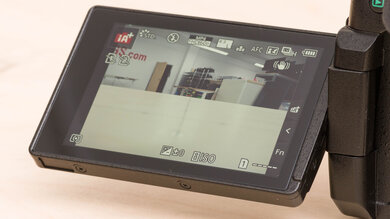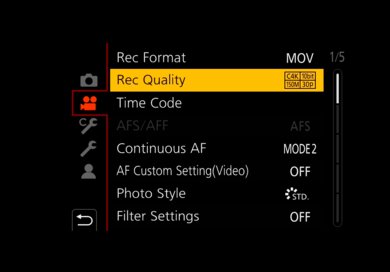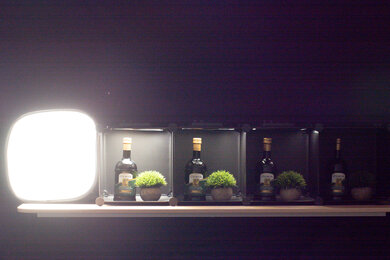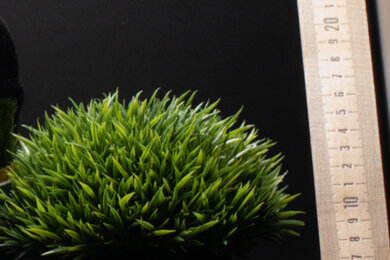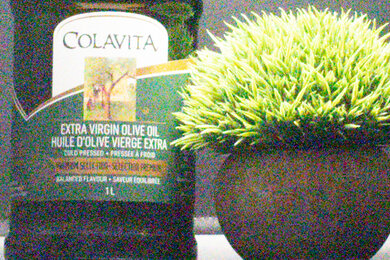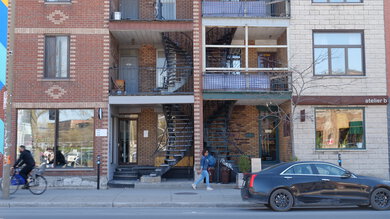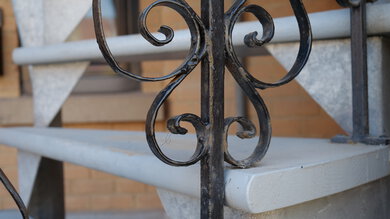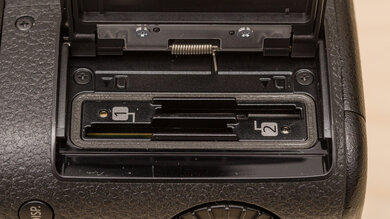The Panasonic LUMIX GH5s is the more video-centric version of the popular Panasonic LUMIX GH5, which was itself replaced with the Panasonic LUMIX GH5 II in 2021. The GH5s has a nearly identical weather-sealed body as its sibling, but internally, it uses a lower-resolution 10.2 MP sensor with dual native ISO designed to optimize the camera's low-light performance. It brings back the multi-aspect sensor from older generations like the GH1 and GH2, meaning the sensor is slightly larger than the lens opening, letting you shoot at different aspect ratios without affecting the camera's angle of view. The other big difference is the lack of in-body image stabilization (IBIS), a curious choice that makes sense when you consider that this camera is aimed at professional videographers and filmmakers who tend to use external stabilization. These key changes to the sensor (along with 4k and Cinema 4k at up to 60p, 1080p slow-motion at up to 240 fps, and no recording time limits) make this mirrorless camera a videography powerhouse.
Our Verdict
The Panasonic GH5s is good for travel photography. It isn't especially portable, but it has an excellent battery life and feels very comfortable to shoot with. Image quality is great straight out of the camera, and if you prefer to shoot RAW, it has good noise handling in low-light situations. It also has a very effective autofocus system for still photos, but it can sometimes lose track of faster-moving subjects.
- Excellent battery life.
- Great overall image quality.
- Sturdy, weather-sealed body.
- Not the most portable camera.
- Autofocus isn't too reliable with faster subjects.
The Panasonic LUMIX GH5s is good for landscape photography. Its sensor is optimized for low-light performance, and it performs well for a Micro Four Thirds camera, with good RAW noise handling to give you some leeway to make exposure adjustments. Its usable dynamic range is also great, so it can capture a fairly broad range of highlight and shadow detail in high-contrast scenes. That said, the lower resolution of its sensor makes it harder to crop in on photos or make large prints without losing some quality and detail.
- Great overall image quality.
- Good noise handling.
- Sturdy, weather-sealed body.
- Not the most portable camera.
- Limited sensor resolution gives you less freedom to crop or print photos.
The Panasonic LUMIX GH5s is good for sports and wildlife. It delivers high-quality photos straight out of the camera for more casual photography, and it does relatively well in low-light situations thanks to its sensor's good RAW noise handling. It has a quick max burst rate to capture sequential photos of moving subjects and a pretty large photo buffer. It also has two SD card slots so you can have a backup ready for long shooting days. That said, while its autofocus system supports human and animal eye detection, it relies on slower contrast-detection technology, which isn't the most consistent when trying to keep pace with faster-moving subjects.
- Two SD card slots.
- Great overall image quality.
- Good noise handling.
- Sturdy, weather-sealed body.
- Not the most portable camera.
- Autofocus isn't too reliable with faster subjects.
The Panasonic GH5s has decent RAW photo performance. Its dynamic range is great, so it captures a pretty wide array of shadow and highlight detail. It also does a good job managing noise in low light. However, the relatively low resolution of its sensor means it doesn't capture as fine a level of detail, giving you less leeway to crop in without losing visible sharpness.
- Good noise handling.
- Great dynamic range.
- Limited sensor resolution gives you less freedom to crop or print photos.
The Panasonic LUMIX GH5s is good for vlogging, especially if you do more at-home or sit-down-style vlogs. It delivers impressive video quality and records 4k and 1080p video at up to 60p. There's also a 'Variable Frame Rate' mode that lets you capture slow-motion video at up to 240 fps in 1080p. The camera has a fully articulated screen, so you can monitor yourself while recording. It also has fantastic internal recording capability, although the plethora of recording formats and video options is overkill for vlogging. While it lacks in-body image stabilization, it has an e-stabilization feature and does a passable job of reducing camera jitter when shooting handheld with an optically stabilized lens. Unfortunately, it isn't the most portable camera for vlogging.
- No recording time limit.
- Impressive video quality.
- Fully articulated touchscreen.
- Not the most portable camera.
- Mediocre autofocus in video.
- No IBIS.
The Panasonic LUMIX GH5s is excellent for studio video. It records both 4k and Cinema 4k at up to 60p. It can also record 10-bit 4:2:2 video internally at frame rates up to 30p, allowing you to take full advantage of the sensor's dynamic range. The camera supports a wide range of recording formats and bit rate options, allowing you to capture high-quality video files. Video quality is impressive, and the camera doesn't impose a recording time limit and doesn't overheat during long shooting sessions. It has a fully articulated screen as well as a full set of inputs and outputs, including a full-sized HDMI port, headphone jack, and microphone input to connect videography peripherals like an auxiliary mic or an external recorder. That said, its video autofocus lags behind some competitors.
- 10-bit 4:2:2 internal recording up to 30p.
- No recording time limit.
- 4k and Cinema 4k up to 60 fps.
- Impressive video quality.
- Not the most portable camera.
- Mediocre autofocus in video.
The Panasonic GH5s isn't meant for action video. It's bulky and isn't designed to be mounted on a helmet or chest rig. It also lacks waterproofing, though it is weather-sealed for light resistance against elements like rain and humidity. Unfortunately, it doesn't do the best job smoothing out camera shake from running or walking since it lacks IBIS. It's also limited to 60 fps in 4k, though it can record slow-motion FHD video at up to 240 fps.
- No recording time limit.
- Impressive video quality.
- Slow-motion recording up to 240 fps in 1080p.
- Not the most portable camera.
- Not fully waterproof.
- Limited high-speed frame rates in 4k.
Changelog
- Updated Jan 29, 2024: Added text to the 'Raw Photo Performance' verdict box and updated existing verdict boxes for clarity and accuracy.
- Updated Jan 29, 2024: Converted to Test Bench 0.12.1.
- Updated Jan 11, 2024: Added a link to the Panasonic LUMIX G9 II in the Sensor box.
- Updated May 17, 2023: Slight adjustments made to 'Photo RAW Noise' and 'Photo RAW Sharpness' text, following the latest test bench updates.
Check Price
Differences Between Sizes And Variants
The Panasonic LUMIX GH5s comes in one color variant: 'Black'. We purchased it with the Leica DG H-ES12060 12-60mm f/2.8-4.0 OIS lens, which you can buy in a bundle with the camera body. You can also buy the camera without a lens.
Let us know if you encounter another variant, and we'll update the review.
You can see our unit's label here.
Popular Camera Comparisons
The Panasonic GH5s is similar overall to the Panasonic GH5 and its successor, the Panasonic LUMIX GH5 II, though the GH5s is more specifically geared towards film and video work. With excellent internal recording capability and a wide range of video resolutions, bit rates, recording formats, and frame rate options, it's a video beast. On top of that, its sensor is designed to optimize low-light performance, with a lower megapixel count and dual-gain ISO to improve light-gathering and minimize noise. Curiously, it doesn't have any built-in stabilization, which can be a benefit for those who prefer to have more external control over stabilization but also gives it worse handheld stabilization than the original GH5.
For more options, check out our recommendations for the best 4k cameras, the best cameras for filmmaking, and the best mirrorless cameras.
The Panasonic LUMIX DC-S5 and the Panasonic LUMIX GH5s use different sensor sizes, and they're aimed at different kinds of shooters. The S5 is a full-frame hybrid camera that's a better fit for those primarily interested in photography. Its larger sensor is more suited to low light and provides better bokeh. It also has IBIS for more stable handheld shooting and an improved autofocus system. However, the GH5s has a bit more to offer for filmmakers, including anamorphic 4k and Cinema 4k up to 60p and All-Intra video compression.
The Panasonic LUMIX GH5s and the Sony α7 III have different strengths and weaknesses. The Panasonic is a better option for videography and filmmaking since it can record 10-bit video internally, offers more 4k frame rate options, and has higher bit rates. While the Sony is no slouch in the video department, it's aimed more at photographers. Its full-frame sensor gives you a wider dynamic range and better low-light performance. It also has a much more reliable autofocus system.
The Panasonic LUMIX GH5 II and the Panasonic LUMIX GH5s are similar cameras and are fantastic video options. The biggest difference between them is the sensor; the GH5 II has a 20.3 MP sensor while the GH5s has a multi-aspect 10.2 MP sensor that's optimized for low light. If you mainly shoot video, and you want better low-light performance, you can't go wrong with the GH5s. However, if you're more of a hybrid shooter, the GH5 II is a bit more well-rounded with built-in stabilization for handheld shooting and an improved autofocus system, along with anamorphic 6k video recording.
Test Results

The Panasonic LUMIX GH5s isn't especially portable. It's about the same size as the Panasonic LUMIX GH5 II, though it's slightly lighter since it doesn't have an IBIS system.
The Panasonic GH5s feels very well-built. Its body is made of magnesium alloy, and it's advertised to be splash-, dust-, and freezeproof down to -14C/14F. The buttons feel sturdy, offer good physical feedback, and the dials turn without slack. However, some of the inputs, like the back control wheel and the joystick feel less premium compared to those of the Panasonic LUMIX DC-S5.
There are a few command dials, including a top dial near the shutter button, a rear dial near the thumb rest, and a control wheel on the back around the 'Menu/Set' button. By default, in Manual mode, the top dial controls aperture, the rear dial controls shutter speed, and the back wheel controls ISO. However, you can also customize these and the five Fn buttons to suit your preferences.
The camera also has a dedicated drive mode dial, making it easy to switch from single shooting to continuous shooting or '4k PHOTO' mode. The main mode dial also includes a locking function, which is handy when shooting a video, for example, and you don't want to accidentally switch modes. The dedicated movie 'REC' button is also catered towards video shooters, making it very easy to start recording at any moment without having to switch modes.
- Panasonic LUMIX GH5s camera body
- Leica DG H-ES12060 12-60mm f/2.8-4.0 Vario-Elmarit ASPH Power O.I.S. lens
- Lens cap
- Rear lens cap
- Sensor cap
- Lens hood
- Hot shoe cover
- Shoulder strap
- 1x Panasonic DMW-BLF19PP battery
- Battery dock charger
- AC adapter
- USB-A to USB-C cable
- USB-A to Micro-USB cable
- BNC converter cable
- Cable holder
- Owner's manual
The Panasonic GH5s is incredibly comfortable to shoot with. It has a large, molded handgrip that feels comfortable to hold. The textured rubber around the handgrip also feels sufficiently grippy. It's easy to change settings with your eye to the viewfinder thanks to the camera's extensive selection of buttons and dials, which are all well-placed within reach of your thumb or index finger.
The touchscreen is fully articulated, making it easier to monitor when mounted on a tripod or when shooting at different angles. It has a high resolution, and you can use the touch functionality to select focus points, as a touch shutter, or to navigate the menu and adjust settings.
The menu system is excellent. The interface is well laid-out, and you can navigate it using the touchscreen, buttons, or the joystick. More advanced settings are a little harder to find, but there are a ton of customization options, and there's also a quick menu that lets you adjust frequently-used settings on the fly.
If you need a camera with a higher-resolution sensor, consider the Panasonic LUMIX G9 II.
The Panasonic GH5s has excellent battery life. It has a 440-shot CIPA rating when shooting through Live View on the screen, but that drops to 410 shots when using the EVF. Panasonic also reports that you can get up to 1300 CIPA-standard shots if you enable 'Power Save LVF Shooting'. All that to say, your mileage will vary based on camera settings and how you use the camera. It's also worth noting that CIPA ratings are just a rule of thumb that is most useful in comparing different cameras. The GH5s has a higher rating than many other mirrorless cameras, though it still falls short of the gold standard of DSLRs. Video battery life is excellent, though, letting you record continuously for long periods without any overheating issues.
The Panasonic GH5s can shoot at a quick burst rate in its high-speed drive mode, allowing you to capture moments of fast action. In addition to low and high, it also has a mid-speed drive mode that can capture stills at 8 fps if you don't need as much speed and don't want to fill up your card with unnecessary frames. It has a very large photo buffer for JPEG files, so you're unlikely to ever fill it up completely when using a UHS-II card. If you're shooting in RAW, the buffer does fill up after about 94 photos, which is still quite large for RAW files. However, it takes fairly long for the buffer to empty once full, which can interrupt your shooting.
The Panasonic GH5s uses Panasonic's Depth from Defocus (DFD) autofocus technology, which is a contrast-detection AF system that determines a subject's distance by constantly making tiny focus adjustments and comparing the relative sharpness at different distances to ensure the subject is as sharp as possible. That makes it faster than traditional contrast-detection systems but results in a constant wobbling or pulsing as the element adjusts back and forth until it finds its target. It's a great system for getting very accurate focus on still subjects but falls a bit short when it comes to moving subjects when compared to cameras with hybrid or phase-detection AF systems, like the Sony α7C.
The camera includes face and eye tracking, and supports both human and animal recognition. It does a decent job, especially with subjects moving at more moderate speeds or without too much erratic movement. However, by virtue of the technology, it can sometimes lose pace with very fast-moving subjects.
If you want more control over the autofocus and prefer to manually select a focus point or use the center point, the camera can keep up with subjects without much issue, especially if you use a lens with a quick focusing motor, like the Panasonic Leica DG Vario-Elmarit 12-60mm f/2.8-4.0 lens.
Unlike the Panasonic LUMIX GH5 or the Panasonic LUMIX GH5 II, the Panasonic GH5s doesn't have in-body sensor-shift stabilization (IBIS). Despite lacking IBIS, you can still get a stabilized image if you use an optically stabilized lens. With the Leica DG 12-60mm f/2.8-4.0 OIS kit lens attached, the camera does an impressive job of stabilizing handheld photos, so you can get clear shots at very slow shutter speeds.
The Panasonic GH5s has great usable dynamic range. It retains a lot of shadow detail in high-contrast scenes like our skate park sample gallery image, which you can download here, although it tends to blow out highlights quite a bit. You have some leeway to recover shadow detail in underexposed photos, but pushing photos too far results in a lot of visual noise and horizontal banding.
You can get very sharp photos from the Panasonic GH5s when paired with a high-quality lens. That said, perceived sharpness depends on a lot of factors, including the quality of the lens, the resolution of the camera's sensor, and any post-processing applied to the image. The Panasonic GH5s's lower-resolution sensor can't capture as much fine detail as higher-resolution counterparts like the Panasonic LUMIX GH5 II; that said, when looking at photos at full resolution, rather than punching in or pixel-peeping, images still look fairly sharp.
The Panasonic GH5s has good RAW noise handling. It outperforms the Panasonic LUMIX GH5 II in low light thanks to its lower-resolution sensor, which gathers more light at the level of individual pixels and results in less noise. It's also helped by dual native ISO, which allows the sensor to achieve cleaner images at higher ISOs. This also gives you a bit more latitude to recover details without sacrificing as much quality.
While the Panasonic GH5s can't record anamorphic 6k video like the Panasonic LUMIX GH5 II, it can record UHD 4k as well as DCI or Cinema 4k (4096 x 2160), and it has an anamorphic 4k mode to get video with a cinematic aspect ratio. It can also output 10-bit 4:2:2 video over HDMI, so you can capture video with greater color information when shooting with an external recorder.
The Panasonic GH5s can record both UHD 4k and Cinematic 4k at up to 60p, improving on the original GH5, which was limited to 24p in DCI 4k. This is great if you want to incorporate slow-motion shots into your video.
The Panasonic GH5s has fantastic internal recording capability in 4k. When shooting in MOV in either 4k or C4k, you can get bit rates of up to 400 Mbps when using All-I compression. When using the max bit rate settings, the camera records in 10-bit 4:2:2, capturing more color information and giving you more leeway in post. However, when recording at 60 fps, or at the minimum bit rate setting, it's limited to 8-bit 4:2:0. You get similar bit rates in MP4 (LPCM), but when recording in MP4 (AAC) format, the camera maxes out at 95 Mbps and is limited to 8-bit 4:2:0.
Overall, the camera offers a ton of recording formats and bit rates to suit whatever you need, whether you want to record higher-quality video files or smaller files for when processing and upload speed are more of a priority.
Autofocus performance is passable when recording 4k video. While Panasonic's DFD autofocus works well in photography, especially for still subjects, it isn't quite fast enough for video and causes noticeable pulsing in the background even after the camera finds its target. The camera supports face and eye detection in video, but it struggles to track moving subjects consistently, often losing faster or more erratic subjects.
The Panasonic GH5s delivers impressive video quality in UHD 4k. Videos look sharp and detailed, and it does an excellent job in low light, retaining a lot of shadow detail without introducing too much visual noise.
Video quality is also great in C4k, which you can see in the video extract here and in the low light sample here.
There isn't too much rolling shutter effect in 4k. It can be noticeable when panning or moving the camera at faster speeds, but otherwise, it isn't too distracting.
As with 4k, the Panasonic LUMIX GH5s can record at up to 60 fps in 1080p, but you can also use its 'Variable Frame Rate' (VFR) mode to capture slow-motion footage at up to 240 fps. However, this mode is only available in MOV, MP4 (LPCM), and AVCHD formats in 8-bit at 100 Mbps.
The Panasonic GH5s has fantastic internal recording capability in 1080p. When using MOV format, you can record in 10-bit 4:2:2 color at up to 200 Mbps, letting you capture high-quality video files with more color information and giving you more freedom in post-processing. There's no recording time limit, either, which is great for shooting longer takes.
Autofocus performance is similarly mediocre in 1080p. It sometimes struggles to keep pace with faster-moving subjects, and there's the same distracting pulsing when it's trying to find its target.
1080p video quality is great overall. The camera does well in controlled lighting, with pleasing colors and relatively sharp, detailed footage. It's impressive in low light as well, with minimal noise and a lot of detail retained in shadows.
There's some rolling shutter effect when shooting in 1080p, but it's mostly noticeable when the camera is panning very quickly. It isn't very distracting for footage with slower camera movements.
The Panasonic LUMIX GH5s has two SD card slots, which is great if you need to keep a running backup for long shooting days. They're also well-placed on the side of the camera, making it easy to switch out cards while the camera's mounted on a tripod.
The Panasonic GH5s has a full set of inputs and outputs, including a full-sized HDMI port, so you don't need to use an adapter. It has both a microphone input and headphone jack, and they're all fairly well-placed on the side of the camera, though some cables could be in the way if you unfold the fully articulated screen.



